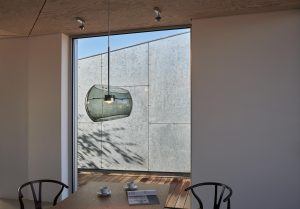Anyone who lives in Düsseldorf knows it: the Bilker Bunker, a legacy from the Second World War and for a long time the city’s problem child. What to do with it? Since the mid-1990s, the facade has been adorned with a huge mural, a memorial to flight, expulsion and the often uncertain departure of distant cultures for a new world. When the building, which is now a listed monument, was upgraded for new uses after many years of discussion, the facade remained largely untouched. The changes took place inside – but especially above. For on the roof a spectacular superstructure was created that provides space for five separate penthouses. The seven floors below are reserved for a variety of uses, such as a cultural center, a music bar, a gallery and studios.
The project was planned and realized by the Düsseldorf architectural firm Anders wohnen in der Stadt, which had acquired the building in 2016 with its own project development company called KüssdenFrosch. A coherent approach: the sale of the penthouses served to finance the cultural conversion of the lower two levels and the two basement floors. Three of the bunker floors were to be made available for commercial use. Despite the rededication of the elevated bunker, the original character of the building had to remain. While the cubes, each two-story and constructed in wood, with living spaces of 97 to 164 m2 on the roof represent a clear break, the interventions in the existing building are kept to a minimum. To ensure that all areas of use harmonize well side by side, the upper floors were accessed beyond to the courtyard side via a new staircase with elevator tower
When furnishing the show apartment, the architects worked closely with the lighting designers from Dinnebier Licht. Since 1956, the Solingen-based company has specialized in the manufacture of high-quality design and custom luminaires and produces a whole range of characterful luminaire collections under the brand name Licht im Raum. In the sample penthouse on the bunker roof, the Ocular Spot ceiling spotlights in the hallway, the Ocular 4 LED pendant lamp above the kitchen island and the Big Moons and Glass Moons 3 pendant lamps are used. The latter with E27 lamp holder, while the other lamps are equipped with high-quality technical lenses. In 1996, Licht im Raum was the first manufacturer ever to launch products of this type on the market – at that time still with halogen light sources – and thus triggered a real trend in lighting design, as Managing Director Daniel Klages recounts.
In many cases, the idea was adopted by other manufacturers. A characteristic feature of the Licht im Raum Ocular series is that the lamps emit light both directly and indirectly and are absolutely glare-free. In the meantime, the principle has long been further developed with first-class LED components. Of course, the lights can be dimmed, for an excellent light quality Licht im Raum works closely with the world market leader Citizen Electronic from Japan.
Another focus of the manufactory Licht im Raum is the omnipresent topic of sustainability. Daniel Klages explains what this means for the lighting design as follows: “The decisive factor for us is where the components for production come from and where manufacturing takes place in the first place. Our goal is to source as much as possible from within a radius of 50 km, and production takes place exclusively in our manufactory in Solingen.” Only a few parts have to travel further: the porcelain parts from Fürstenberg, for example, the glass lampshades from the Czech Republic, or the installed chips from Japan and China. The technical lenses come from southern Germany. “The proximity to our main suppliers allows us to realize special configurations in the shortest possible time,” Daniel Klages proudly emphasizes.
